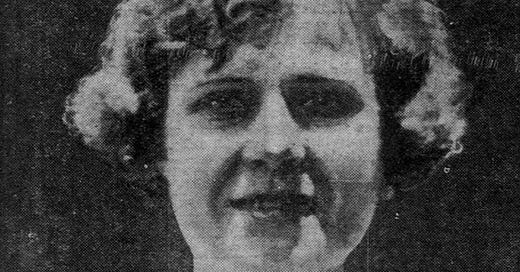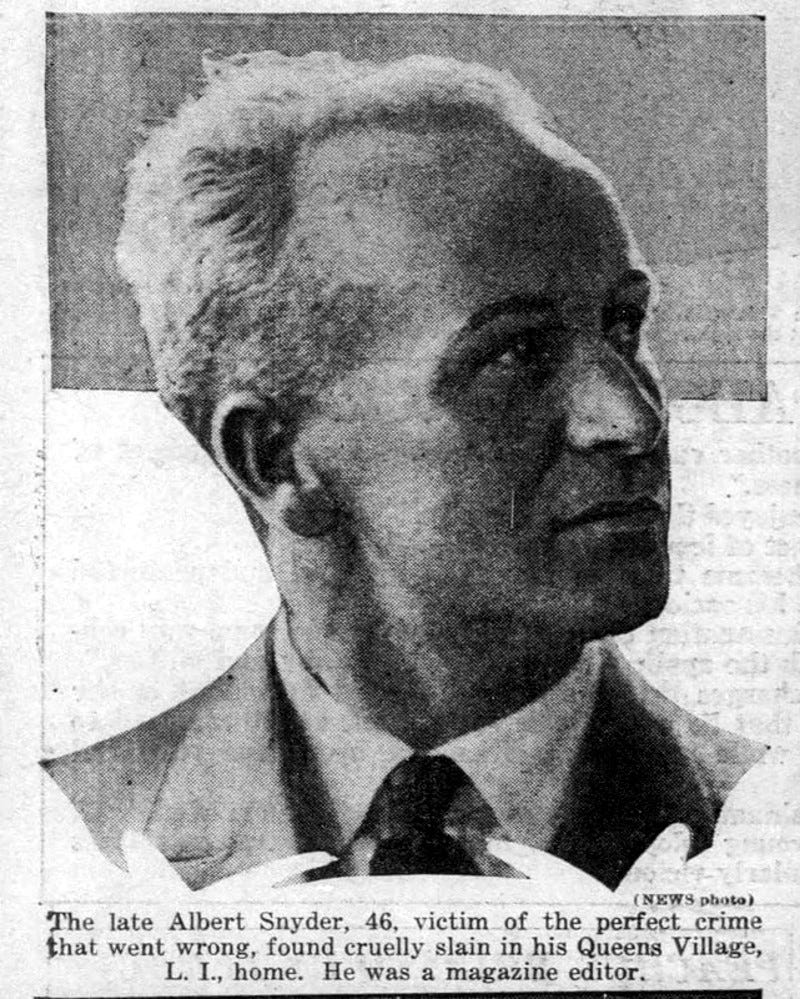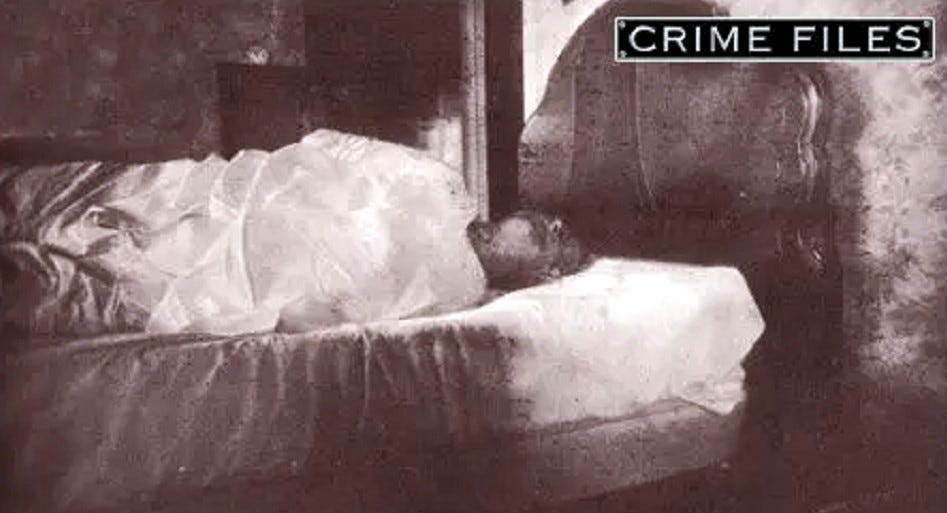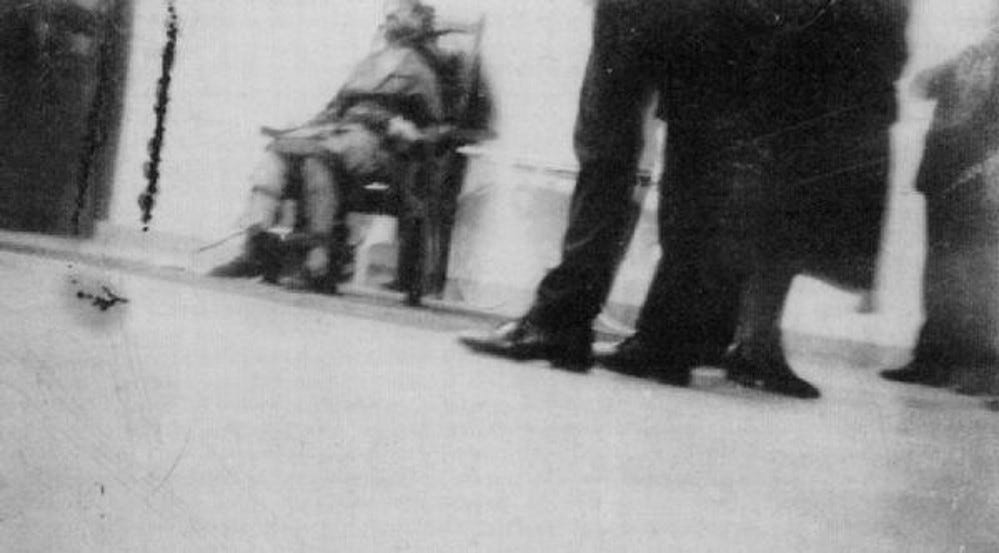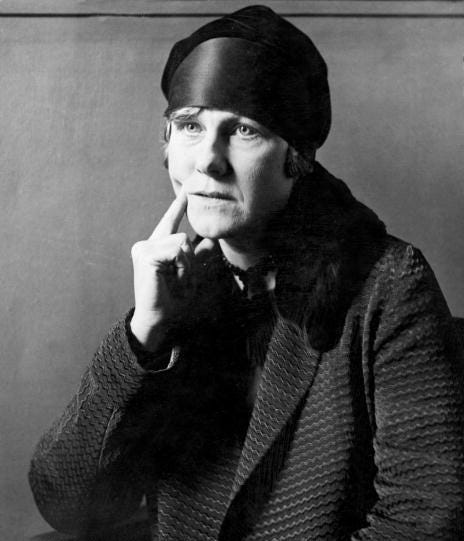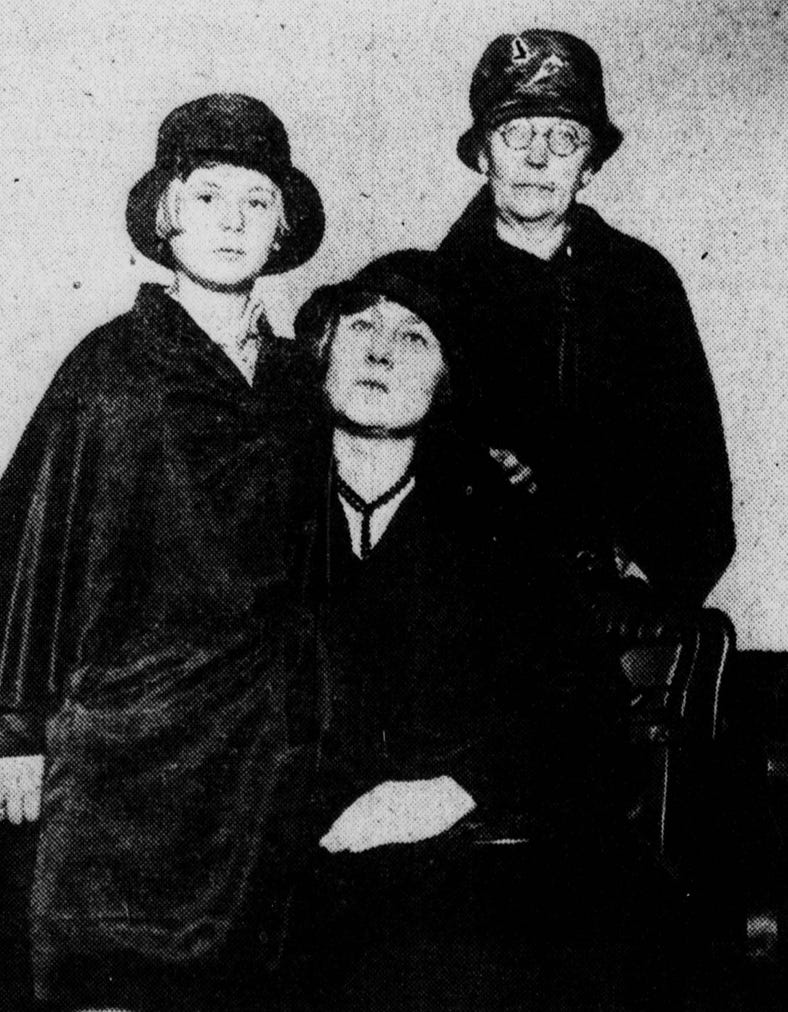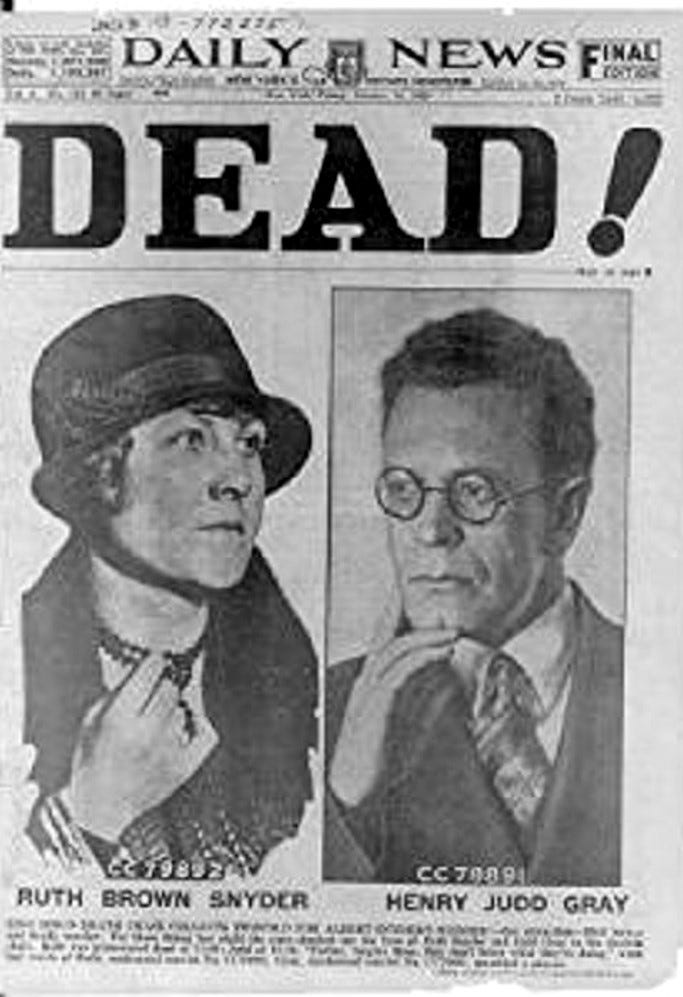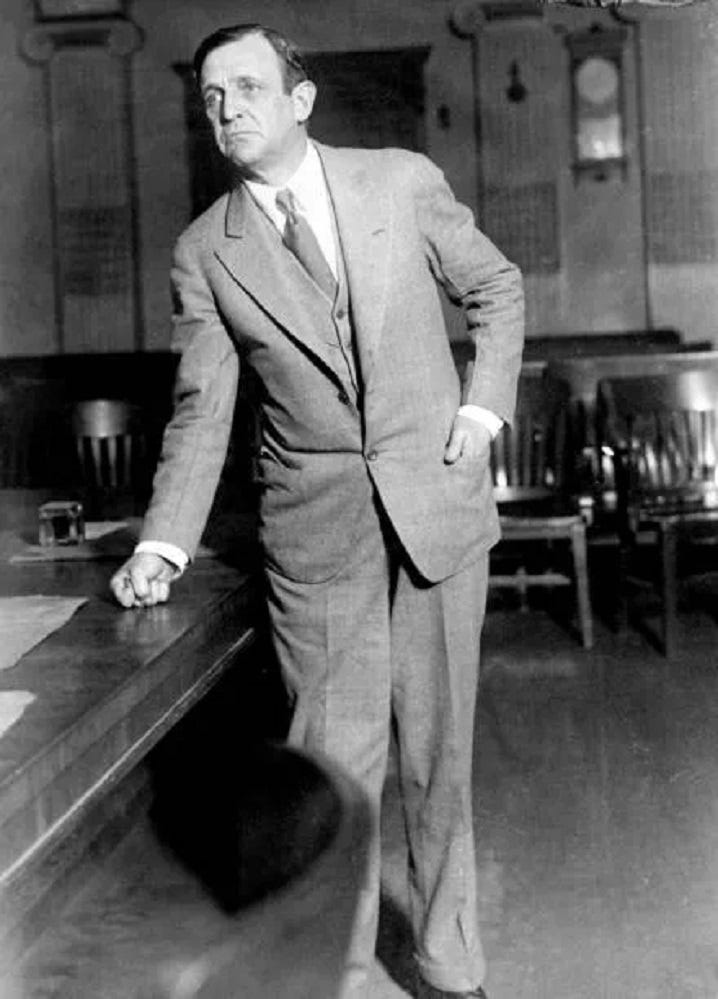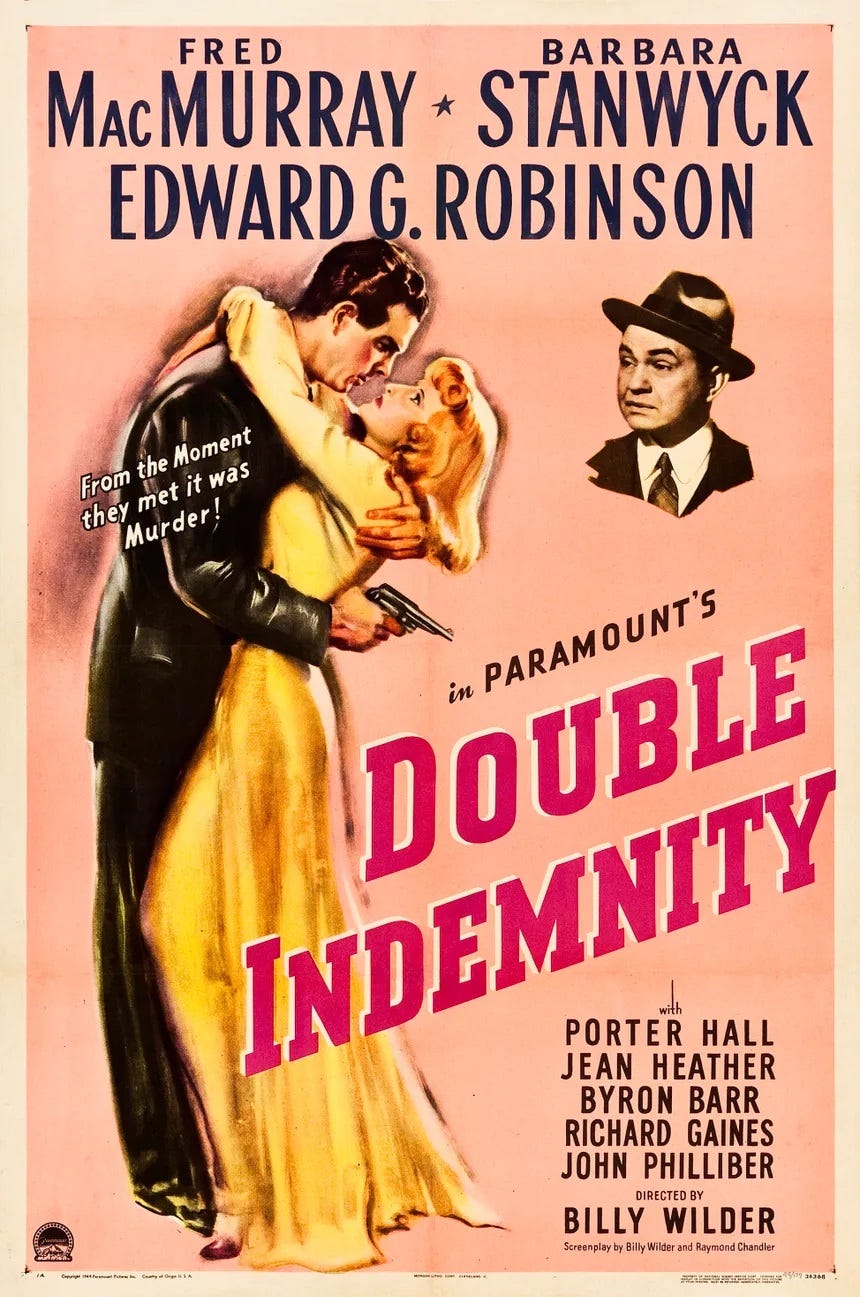Ruthless Ruth Brown Snyder
The thrill-hungry populace of the Roaring 20s got a whopping plateful of it with every sordid detail that was covered by the newspapers about the discontented housewife turned murderer Ruth Snyder.
On January 12, 1928, Ruth Brown Snyder became the first woman to be executed in Sing Sing since 1899. She went to the electric chair only moments before her former lover. Her execution was caught on film as the electricity was running through her body, with the aid of a miniature plate camera custom-strapped to the ankle of a Chicago Tribune photographer. None would have thought this is how Ruth would end her days.
Ruth Snyder was a 32-year-old, tall blonde with a forceful personality. It was 1925, the Roaring 20s were in full swing and this discontented, Long Island housewife felt herself left behind.
Perhaps it was this desire to break up the monotony that propelled her into an affair with Henry Judd Gray, 34, a married, corset salesman she had met when having lunch in New York City. It wasn't for his looks — he was short and wore thick glasses, but the pull of these opposites could not be denied.
The Snyder marriage was in trouble long before the pair met. Albert was 13 years older than his bride, and he wanted to lead an ordinary life, with little or no excitement. She wanted to dance and have a good time, and she had no interest in his passions of hiking and camping. He didn’t want to have children, and was disappointed when Ruth became pregnant, and even more so when she had a girl.
.At some point Ruth’s mother moved in, and acted as a babysitter for her granddaughter. This allowed Ruth more opportunity to attend parties, where she was nicknamed by friends “Gay Tommy”.
Albert Snyder (Schneider), was the art editor of the magazine Motor Boating, and put in long hours at work, leaving the couple plenty of time and opportunity to meet and consummate their torrid affair. They would meet at the Snyder's house with only Ruth's 9-year-old daughter Lorraine as witness, and at other times they would leave the girl waiting in the lobby of a hotel while they went off to a room for a couple of hours.
Later, when interviewed by police she said, “Mama and Papa quarreled lots." She also told them her mother often spent the night away.
At what point Ruth started to make plans beyond her next meeting with her lover is unknown. Imitating art before it was life she turned into the mysterious siren of future film noir films, by pleading mistreatment at the hands of her husband, then subtle hints that only his murder, and not divorce was the way to remedy the situation.
But indeed it seems that Ruth had been planning this long before she met Gray, and was waiting to come across a patsy to put her scheme into action. Her distaste for her husband flowered into full bloom hate when he insisted on hanging a picture of his late fiancé, Jessie Guishard, who had died from pneumonia right before their wedding after a 10-year engagement. He then named his boat after her, and the house they lived in was the one Snyder had bought for his married life with Jessie.
Ruth persuaded her husband to purchase a $48,000 life insurance policy that paid extra (double indemnity) if he died due to an act of violence. Later during the trial when her lover had turned on her, Gray alleged that Ruth had made at least 7 attempts to kill her husband, which he survived and left him none the wiser to what she was trying to do.
Once Albert was in the garage changing a tire when the jack slipped and barely missed getting killed. Then another time he was knocked unconscious by a crank that hit him.
A third garage incident occurred when Albert drank some whiskey his wife brought him, while he tinkered under the Buick they owned. He noticed he was suddenly very sleepy, however he was alert enough to realized the garage door was closed, and he was breathing carbon dioxide. Panicked, he fled and escaped.
Initially Gray told her she was crazy, but she continued to pester him, ending with outright demands for his help which culminated in torrid love-making, while calling him by his pet name of "Bud" or "Lover Boy".
Unable to commit murder or deny his lover, he started to drink heavily, and her persistence was rewarded when on March 19, 1927 he gave in. They laid out a plan in which he would travel by train to New York from Syracuse, and then by bus to Long Island. Bolstering his courage throughout the day with liquor, he went to the Snyder home in Queens Village where he slipped in through a back door left open by Ruth.
She was away with her husband at a party and returned at 2 AM. Albert Snyder fell into a deep sleep, and Ruth wearing only a slip met her lover in a spare bedroom where she had left gloves, a window sash weight and chloroform. They had sex while Albert slept. When they finished she led Gray back to the bedroom where her husband slept with the covers over his head. He then brought the weight down on Snyder's head, but all it did was enrage the sleeping man as it glanced off his skull, and he let out a yell and tried to grab his attacker.
In true psychopathic fashion, Ruth grabbed the weight from him, and finished the job by smashing her husband's skull in. Afterwards he was garroted with fine picture wire, and it was not known if he was dead when it was twisted tightly behind his neck. His hands were bound with the same wire behind his back, his feet with a necktie and a gag was fastened in his mouth. They also used chloroform on him. Snyder’s cause of death was suffocation.
The lovers went downstairs, had a drink and chatted about executing the next part of their plan, which was to stage the crime like a botched robbery. Gray tied Ruth's hands loosely behind her and once he had left she went to her daughter's bedroom and banged against it. She sent the little girl next door for help and the police immediately responded.
The first thing the police noticed was that the burglar had left little evidence, and the detectives looked at each other knowingly when they realized that she showed little emotion for a woman who had been terrorized, and whose husband had just been murdered.
Then they found the property which Ruth claimed had been stolen hidden in the house. They also found Ruth’s diary, where she wrote openly about her affair with Judd Gray and her contempt for Albert. When the police found a pin with the initials "J.G.", which in reality referred to Jessie Guischard, a detail which was overlooked by a flustered Ruth who thought of her lover's initials which were the same, she stupidly asked what Gray had to do with the matter, and the police instantly became more suspicious.
With a name it was not difficult to find Gray. They caught up to him in Syracuse. A friend had manufactured an alibi for him by renting a room at a hotel under his name, which quickly came apart when the police found his discarded train ticket in the trash. They also found a light blue shirt that belonged to Albert Snyder. Gray was returned to Jamaica, Queens.
Before his meeting with Snyder, Gray’s life was dull and safe. He graduated from high school, had no criminal record, didn’t use drugs, and only smoked and drank. All he had in his pocket when arrested was $8.50.
Ruth was no worse. She had an 8th grade education, she drank occasionally and had no criminal record.
The trial was held at the Long Island City Courthouse. It was covered by crime reporters, authors and Hollywood stars, and was dubbed the Dumbbell Murder case, due to the method used to carry out the attack, or perhaps for the stupidity of the murderers.
In the end, even though each blamed the other for the planning and execution of Albert Snyder's murder, they were both convicted and sentenced to death.
Less than a year since her husband was killed, Ruth Snyder walked to her death minutes before her lover. During her incarceration, custody of her daughter Lorraine played out between both sides of the family. On September 7, 1927, her maternal grandmother Josephine Brown was awarded guardianship of the girl, after a legal battle with the girl’s paternal uncle Warren Schneider. Ruth refused to have her daughter visit her in prison, and she wrote a sealed letter to be given to Lorraine when she was old enough to understand.
Only one of the three life insurances for Albert Snyder were paid off by the companies in the amount of $4,000 for the maintenance of Lorraine Snyder. The other policies were not paid since the insurers claimed they had been filed fraudulently when Ruth forged her husband’s signature. The Brown family lawyer asked the court to allow them to appeal without a printed record, on the basis that the family was destitute and unable to sell the house due to the notoriety of the case.
Ruth was interred in Woodlawn Cemetery in the Bronx, along with other Brown family members.
In 1944, the movie Double Indemnity, featuring Barbara Stanwyck and Fred MacMurray, was based on the Ruth Brown Snyder and Henry Judd Gray crime. In 2007, the American Film Institute listed Double Indemnity as the 29th best movie on their list of the top 100 American movies of all time. The double indemnity insurance policy was declared invalid in 1930.


